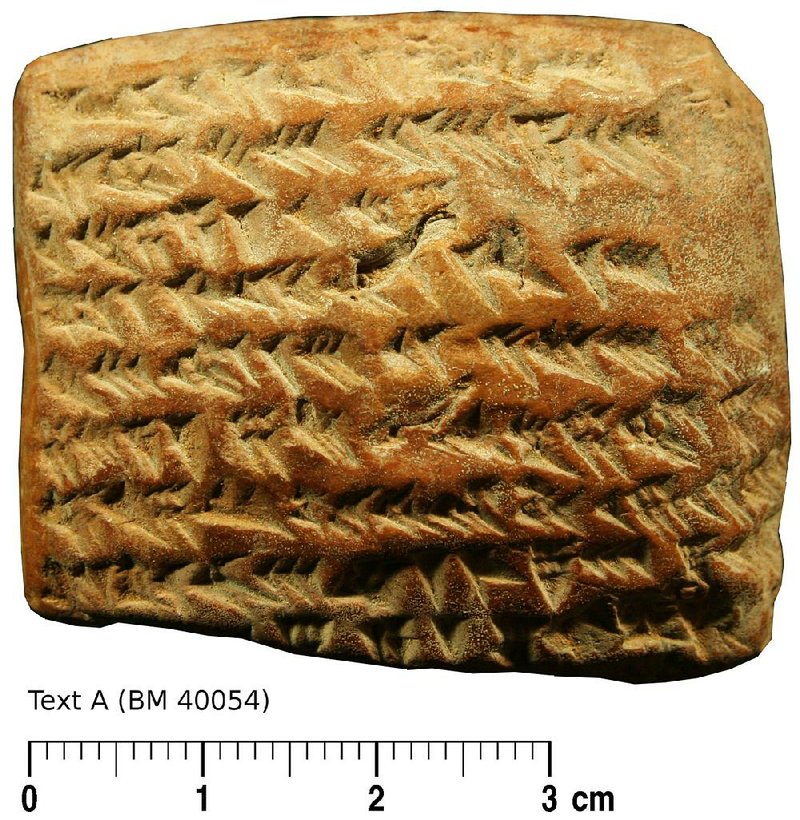The medieval mathematicians of Oxford, toiling in torchlight in a land ravaged by plague, managed to invent a simple form of calculus that could be used to track the motion of heavenly bodies. But now a scholar studying ancient clay tablets suggests that the Babylonians invented it first, and by at least 1,400 years.
The astronomers of Babylonia, scratching tiny marks in soft clay, used surprisingly sophisticated geometry to calculate the orbit of what they called the White Star -- the planet Jupiter -- one expert says.
The tablets are incomprehensible to the untrained eye. Thousands of clay tablets -- many unearthed in the 19th century by adventurers hoping to build museum collections in Europe, the United States and elsewhere -- remain undeciphered.
But they are fertile ground for Mathieu Ossendrijver of Humboldt University in Berlin, whose findings were published Thursday in the journal Science. Ossendrijver is an astrophysicist who became an expert in the history of ancient science.
For a number of years he has puzzled over four particular Babylonian tablets in the British Museum in London.
"I couldn't understand what they were about. I couldn't understand anything about them, neither did anyone else. I could only see that they dealt with geometrical stuff," he said in a phone interview from Germany.
Then one day in late 2014, a retired archaeologist gave him some black-and-white photographs of tablets stored at the museum. Ossendrijver took notice of one of them, just 2 inches across and 2 inches high.
This rounded object, which he scrutinized in person in September 2015, proved to be a kind of Rosetta Stone.
Officially named BH40054 by the museum, and dubbed Text A by Ossendrijver, the little tablet had markings that served as a kind of abbreviation of a longer calculation that looked familiar to him.
By comparing Text A with the four previously mysterious tablets, he was able to decode what was going on: It was all about Jupiter. The five tablets computed the predictable motion of Jupiter relative to the other planets and the distant stars.
"This tablet contains numbers and computations, additions, divisions, multiplications. It doesn't actually mention Jupiter. It's a highly abbreviated version of a more complete computation that I already knew from five, six, seven other tablets," he said.
Most strikingly, the methodology for those computations used techniques that resembled the astronomical geometry developed in the 14th century at Oxford. The tablets have been authoritatively dated to a period from 350 B.C. to 50 B.C.
The people of Mesopotamia -- now Iraq -- developed mathematics about 5,000 years ago. Among them were the Babylonians who wrote in cuneiform script and, over time, adopted a sexagesimal (base 60) numbering system. Early mathematics was essentially a form of counting, and the things being counted were mostly sheep and the like.
Mathematics progressed, as did the sharing of knowledge in the wake of Alexander the Great's conquering journeys across Asia. The ancient Greek astronomer Aristarchus of Samos argued for a heliocentric universe -- one in which Earth orbited the sun, contrary to what seems to be the case when one looks at the sky. That view was shared by another astronomer, possibly Greek as well, who lived in Mesopotamia on the Tigris River and was known as Seleucus of Seleucia.
But Ossendrijver said nothing in the newly decoded computations suggests that the ancient scientist or scientists who etched the tablets understood that heliocentric model.
The calculations merely describe Jupiter's motion over time as it appears to speed up and slow down in its journey across the night sky. Those calculations are done in an abstract way -- the same way the Oxford mathematicians did them a millennium and a half later.
"It's geometry, which is itself old, but it's applied in a completely new way, not to fields, or something that lives in real space, but to something that exists in completely abstract space," Ossendrijver said. "Anybody who studies physics would be reminded of integral calculus."
Integral calculus was invented in Europe in 1350, according to historians.
"In Babylonia, between 350 and 50 B.C., scholars, or maybe one very clever guy, came up with the idea of drawing graphs of the velocity of a planet against time, and computing the area of this graph -- of doing a kind of computation that seems to be thoroughly modern, that is not found until 1350," he said.
Alexander Jones, a professor at New York University's Institute for the Study of the Ancient World, praised Ossendrijver's research, which he said shows the "revolutionary brilliance of the unknown Mesopotamian scholars who constructed Babylonian mathematical astronomy during the second half of the first millennium BC."
SundayMonday on 01/31/2016
